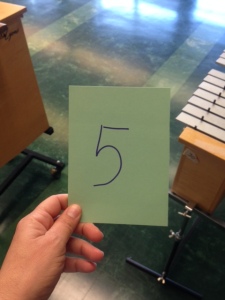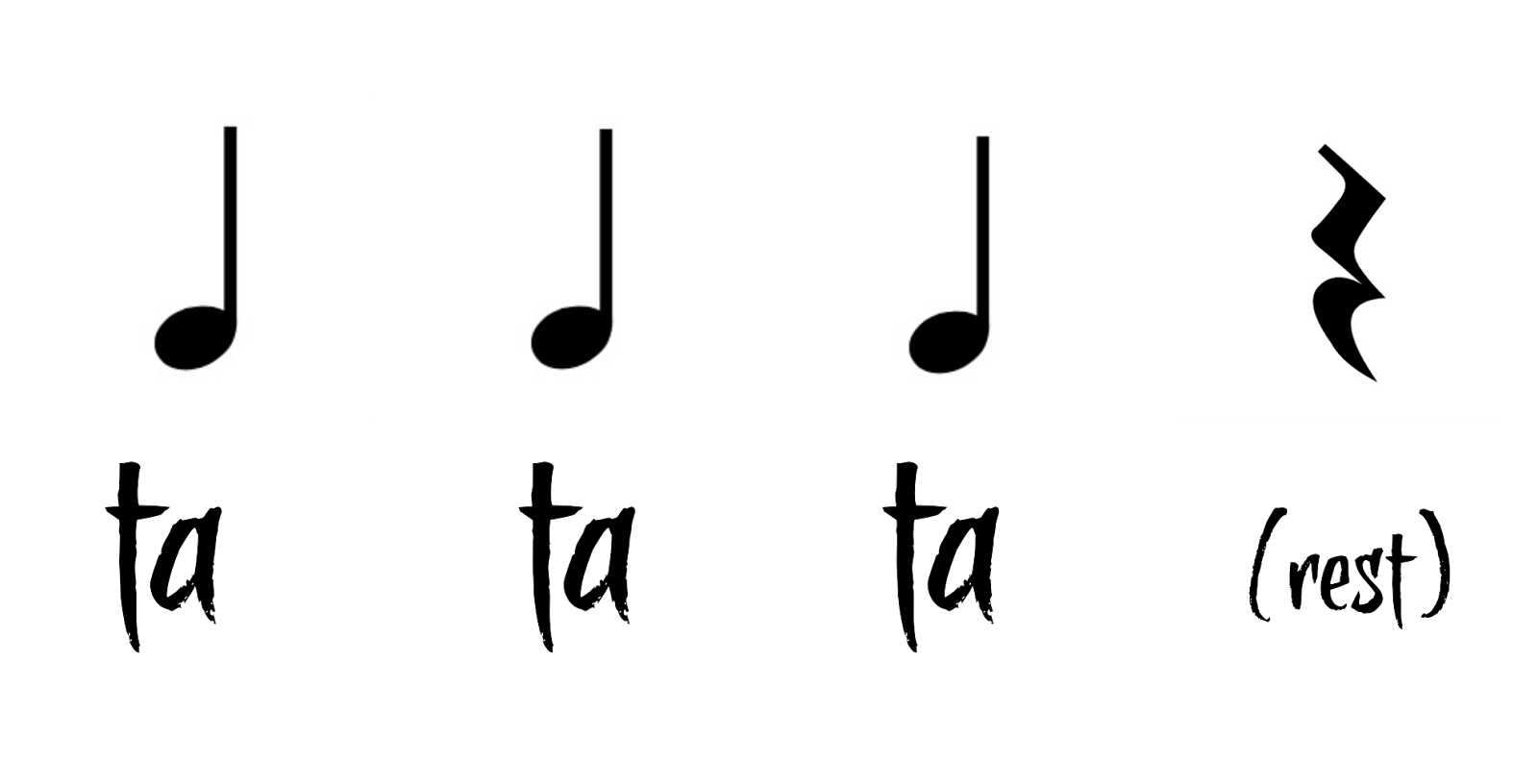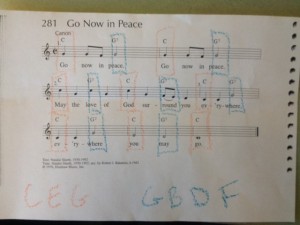Tagged: Feierabend
Music Class: October 12 – 16
HERE’S WHAT WE DID:
Veteran’s Day Song – Bless Our Troops (4th)
4th grade is preparing a solemn, hymn-like song for the school Veteran’s Day program. Click HERE to hear a reference recording of this song.
Brahms’ Hungarian Dance No. 6 from Kids Can Listen, Kids can Move! (K, 1st)
This listening activity has brought giggles to many early childhood and primary grade level students. In the past I have added props: crowns, long skirts, sashes.
Great Big House In New Orleans (3rd, 4th, 5th)
Lots going on with this song: Reinforcing mi-so-la, we kept a patchen ostinato for part work, steady beat.
Overall, I’ve never witnessed such a positive response to “weaving the basket.” Some students asked if they could weave the basket again at the next class. This video is an excellent reference for weaving the basket:
Do-Re-Mi Patterns (3rd, 4th, 5th, 6th)
With inspiration from the Pattern Sets in Conversational Solfege, I am using the pictured patterns to introduce do-re-mi reading to the upper grades. The 5th is taking to it quite well.
Folk Dance Friday: Letkajenkka
Strong Finnish roots in my new upper midwest home inspired me to teach this cardio-workout folk dance. The bunny hop totally copped it:
Music Class: October 5 – 9, 2015
HERE’S WHAT WE DID:
Keeping the Beat: Concerto No. 10 in C Major: Allegro by Arcangelo Corelli (love his name!) (K, 1st, 2nd, 3rd, 4th, 5th)
Beat motions are big this week! I have owned this under-utilized CD for years. This year, I am going to be more faithful to it. We “moved” to the Corelli on Monday, and when I started playing it on Friday, the students recognized it immediately and started grooving.
King’s Land (K & 1st)
This “so-la-so-mi” singing game with final “do” is thrilling for Kindergarten, 1st grade, toddlers, and Pre-K types. I change “Boston” to London and instead of tagging, encourage all the beat keeping/dancing students to music-room run back to their benches when the alert sounds that the king is approaching (me furtively ringing a tone chime). This game will serve as a segue to a “movement for form and expression” activity next week featuring the King, Queen, Prince, Princess, and a Hungarian Dance, by Brahms.
See the Autumn Leaves (K, 1st, 2nd, 3rd, 4th, 5th)
OForTunaOrff.Blogspot is quickly becoming one of my go-to inspiration resources. This little fall ditty was a seasonal opportunity to discover rest (silent beats), aurally decode for ta and titi, play instruments on an assigned rhythmic phrase, distinguish between beat and rhythm, and more!
Music Class: September 28 – October 2, 2015
HERE’S WHAT WE DID:
Chant Rhythm Set 1A with Carnival of the Animals Finale (2nd, 3rd, 4th, 5th)
We chanted the rhythms without music.
To keep the older grades on their toes, I held up a card with the number of the rhythmic phrase (1 through 8) that I wanted them to chant. The younger grades just went in order.
The Finale from Carnival of the Animals works perfectly for accompanied chanting: the introduction gives me just enough time to press play and run to the board! There’s also an interval during the music where you can stop chanting and take a break for a few seconds before picking back up.
Xylophone Ostinato for Scotland’s Burning
Students played a simple ostinato on their shoulders and xylo/metallophone C-F (curly fries) while singing Scotland’s burning. Before taking their turn on the instrument, the student gets “trained” by the previous player. This ostinato was difficult for some, especially after the first phrase of the song. Tapping the ostinato rhythm on the player’s shoulders seemed to help.
Go Now In Peace by Natalie Sleeth with tone chimes!
We’ve been working on this simple dismissal song for both classroom and Mass. It was also a nice opportunity to learn about chords (C and G7). Color coded scores are a quick and easy way to get students on the tone chimes:
Music Class: September 21 – 25, 2015
HERE’S WHAT WE DID:
Modified Name Games: Did You Ever See a Lassie (K &1st) Oliver Twist (2nd, 3rd, 4th, & 5th)
Learning student names, when you are new to a school, is a special task known well by all general music teachers. This week I modified some popular beat motion games to suit my name learning motives! We sang Did You Ever See a Lassie several times so I could model ideas for beat motions: shoulder tap, toes tap, bending knees, wavy arms, groovy thumbs, etc. After which, most students get the idea and come up with their own. Glancing at my class roster, I replaced the word “lassie” with a student’s name, “Did you ever see an Emma,” prompting the named student to show everyone a new motion of her choosing.
Oliver Twist got the same treatment with the older students. This time I replaced the word “Oliver” with a student’s name: “Cody” Twist, you can’t do this.” The 3rd graders loved this game the most and were very excited about showing off their original beat motions. I like adding complexity to this game by having the students come up with 1) their own beat motion and 2) the next person to be named in the game.
So much is going on in these singing games: singing the song over and over, doing a beat motion while we sing and watch each other, deciding what your new beat motion is going to be, or deciding to do one suggested by the teacher or the other students, and, for the older students, deciding who you are going to name. Surely this is all good, clean, fun exercise for young brains.
Moving for Form and Expression: Brahms‘ Waltz in A-Flat Major, Op. 39 No. 15
I added fake fall leaves (50 for $1 at the dollar store) to this lovely movement activity from First Steps in Music for Preschool by John Feierabend. The Kindergarten and first grade students impressed me with their graceful motions and sensitivity to the music. At first I used the piano version, but this string version was a better fit with less rubato. Next week we’ll use the leaves for movement in Vivaldi’s Autumn for a nice contrast.
Folk Dance Friday: Zemer Atik (5th grade)
After a busy week, there is nothing more relaxing and smile-inducing than a folk dance. Zemer Atik was a small, but thoroughly enjoyable challenge for the 5th grade this week. They even asked to do it again on the following Monday! I like the way the dance is taught in this video:
Music Class: September 14 – 18, 2015
HERE’S WHAT WE DID:
Big Pig (K, 1st, & 2nd)
This pitch exploration dialogue between “Big Pig” and the Farmer’s Wife (that’s my take on it this year) was a big hit with the kindergarten, first, and second graders. They performed as the characters in groups using their “Big Pig” low voices and and ridiculously high, southern draaaaaw-ulled “Farmer’s Wife” voices. Volunteers got to hold Big Pig and help him dig. Cuteness abounded. Listen to the track here.
Rhythm Set 1A & Debka Tora (2nd, 3rd, 4th, & 5th) Mystery Rhythm
Rhythm Set 1A is a set of eight, two measure long patterns consisting of barred eighth notes and quarter notes. The phrases are straight out of typical folk songs; not difficult, but challenging enough to keep the students’ interest. We echoed the patterns with rhythm syllables (I use ta, and titi) and practiced using other drill techniques like making all the ta’s silent, red shirts say the odds, blues, evens, etc.
Later in the week, I taught the song, Debka Tora, with circle dance. H/T Alisha Gabriel
H/T Alisha Gabriel
Dance: Before dance begins, assign symbol or number for two groups. I used peaches/cream. Grapevine to the left for two measures, grapevine to the right for next two measure. Peaches walk four steps to the center then back, Creams walk four to the center then back.
After once through the Debka Tora, I chant one of the rhythms from the set (at first with syllables, later played on drum). Students take turns pointing to the rhythm on the board as we chant it together. Then back to the dance as a “reset.” There’s a lot going on in this kind of activity, but I love seeing the student’s engagement throughout.
I’ve Been to Haarlem, I’ve Been to Dover
Interestingly, the students who immediately identify this activity as “the cup song/when I’m gone” have some difficulty doing the cup motions with new words. We paired it with Sousa’s Washington Post March to really change it up.
I sing it with these words:
I’ve been to Haarlem, I’ve been to Dover
I’ve traveled this wide word all over
Over, over, three times over
Drink all the apple juice and turn the glasses over
Record, Reflect, Receive
Welcome to a new school year and a new blog about teaching music in a Catholic School. You can learn more about me and my previous experiences here.
My primary blogging goal is to record, reflect, and eventually receive input and thoughts from other Catholic music teachers.
I am new to my position, which began with in-service last week and students this past Tuesday.
So far this week:
6th, 7th, & 8th grade students, who are not in Band, come to a class with me called “Music” for about 40 minutes.
I see the K, 1st, 2nd, 3rd, 4th & 5th for 30 minutes twice a week. (This first week I only saw them once)
I see ALL the 6th, 7th, & 8th grade students (one period per grade) once a week for a semester class we are calling Liturgical Music Ensemble. This class is a fix to a scheduling issue with the new band director. I will blog about this class and the weekly school masses that I help organize in the Liturgy section.
I planned activities that required little to no prep and that would give me a chance to get familiar with the students and their basic skills.
HERE’S WHAT WE DID:
Music Prayer
While I sing the music prayer, decide why some of the words are underlined. If you know, don’t say out loud so others can continue to figure it out. Using your finger tips, silently tap the rhythm of the words on the heel of your palm, making bigger circles for long sounds and baby circles for the faster parts.
While you tap, “mouth” the words as I sing the prayer. Now sing it with me, making the sign of the cross as we sing that part.
Sammy Sacket (K, 1st, & 2nd)

H/T Mrs. Miracle’s Music Room http://www.mrsmiraclesmusicroom.com/2014/11/second-grade-favorite-folk-song.html
As I walk around the room singing the song, I tap individual students on the shoulder to join my line. I do various beat motions with my hands and arms that the students copy. If the students are reluctant singers, I remind them that this boat is powered by song, so when’s there’s not enough singing, the boat (or whatever) can’t continue. When a singing game is over, I almost always sing the transition directions (when I tell you, go back to your first seat, etc.) to the melody of the game song.
Airplane Ride (K, 1st, 2nd, 3rd, 4th, 5th)

Airplane Ride is a pitch exploration story adapted by John Feierabend in his book, First Steps in Music (pictured). I pretty much live out of this book for most of the year, mainly with lower elementary, but often with older students.
No More Pie (K, 1st, 2nd, 3rd, 4th, 5th)
From First Steps in Music. We sang this echo song, followed by “Airplane Ride,” then came back to “No More Pie” while I played alternating D and A on the soprano metallophone. I end “No More Pie” with an extra oh, my/no more pie sung pianissimo, and accompanied by descending minor triad, to give a sense of a special ritardando ending.
Circle Round the Zero (2nd, 3rd, 4th, 5th)
From First Steps in Music. This is a fun “choosing” game/practice walking in a circle game. I’ve played it with all ages. Some students get a little weirded out by the the word, “lovin’,” but they usually get over it pretty quickly.
Epo I Tai Tai E (3rd, 4th, 5th, 6th, 7th, 8th)
I revisited this song found in FSM, after discovering it on a great Kodaly blog: Music a la Abbott. I started by teaching only the patschen with the words, “tuki tuki” thrown in, echo singing with patschen, then replacing the four shoulder taps with tapping the index finger of the person on the right. My 6th grade class (6 sweet girls) added the sticks, with just one handed tosses on Tuki Tuki.
Les Saluts
After a life altering week-long Dalcroze workshop at UT San Antonio, I am a passionate folk dancing advocate. Folk dancing is relaxing, most kids enjoy it, and an easy one like Les Saluts gives you time to observe your students while they observe you enjoying the dance.




